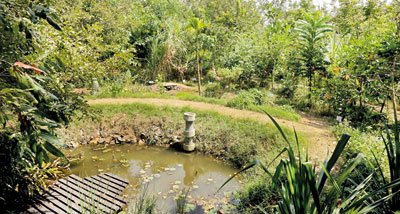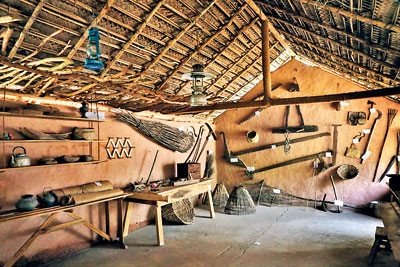Keep a date and take a green break

Green oasis in Moratuwa: The small wewa that feeds the paddyfield in the arboretum. Pix by M.A. Pushpa Kumara
As the noon sun beats down mercilessly on the men, women and children hurrying about in the asphalt jungle that is Katubedda, Moratuwa, on the outskirts of Colombo, there is an oasis of greenery exuding an aura of serenity and comfort.
Nestling within tea giant Dilmah’s Merrill J. Fernando Centre for Dignified and Sustainable Development sprawled across a large urban estate just off busy Galle Road with its honking and speeding vehicles, is the unique ‘One Earth Arboretum’.
It is on Wednesday that we retrace the footsteps of President Maithripala Sirisena who, accompanied by Dilmah Founder Merrill J. Fernando, inaugurated this first urban arboretum within a bustling town a day before.
We enter a wonderful world, firstly going back in time to the tools used by our forefathers exhibited in a large mud-hut thatched with cadjan. Although it is a ‘govi-geyak’ having on display not oft-seen nagulas (ploughs) and roughly-made footwear, there are also rare fishing tools such as wakkada.
In through the front-door and out through the rear door, we come upon the arboretum adorned by big and small trees, 500 species in all, meticulously named in Sinhala and English along with the botanical names.
Our attention is drawn to the QR Code on the name-tags of the trees by the Supervisor of Dilmah Conservation’s Sustainable Agriculture Research Centre, Radun Wickramage whose green T-shirt sports the saying, ‘Business is a matter of human and environmental service’.
Explaining that it is near-impossible to have all the details about a particular tree on a small tag, Radun points out that those who go walkabout in the arboretum would be able to capture the QR Code on their smart phones, link it to the Dilmah Conservation website and be privy to all information about that tree at their fingertips.
It is also not a simple walk in the park, but a learning experience, with a tiny ‘hena’ (chena) showing off its kurakkan (finger-millet), bada-iringu (corn), manioc and thala (gingelly) along with a pela (hut) and farther into the arboretum a little piece of paddy-land, the dark green shoots of al-wee, a traditional rice variety swaying in a gentle breeze, while a takaya is at hand to scare off birds and a pambaya (scarecrow) with its walang-head guards the land.
The paddy-field is irrigated by a small wewa (tank), built in the traditional manner, proudly offering a single purple water lily.
“Did you know that when the ancients built wewas, the keta sorowwa which fed the fields with water had around it a kadolana (mangrove) environment,” asks Radun, telling us that it was meant to purify the water of pollutants such as arsenic and cadmium which would have been naturally present in small quantities in the soil then, unlike now with heavy pesticide use. The tank-bund was made of soil, which allowed the mangroves to prosper, as they in turn acted as a barrier against soil erosion.
To meet the rala-panawa (pressure of waves in the tank), the pita-wanawould be fixed at the lowest gradient of the tank, as otherwise the bund would get weakened due to the onslaught of the waves.

Going back in time: The tools used by our forefathers exhibited in a large mud-hut thatched with cadjan.
Close to the paddy-field, amidst several large trees is also the basic tools used by the ancients to thel-hindinna (extract oil from the tree leaves).
A Dilmah Conservation spokesperson, meanwhile, said that the ‘One Earth Arboretum’ is an urban biodiversity experience designed to present the aesthetic, functional and psychological value of nature in an interactive and educational facility. It hopes to propagate the importance of respectful co-existence among humans and nature.
“Nature renders benefits that are vital for the existence of humankind. These ecosystem services, which are unfortunately irrevocably over-exploited for commercial gain, include recycling of nutrients, formation of soil for food production, water purification and flood prevention,” he said, adding that the other services include water, genetic resources for medicines, food, minerals, energy and regulating services such as water and air purification, carbon sequestration and climate regulation. Cultural services include recreation, therapy and scientific knowledge amongst others.
The spokesperson said that research confirms that urbanization fosters apathy towards the environment and wildlife. The implications are alarming, both for human welfare and the consequences of biophobia amongst urban populations. With 55% of the world’s population currently living in cities, promotion of biophilia and better understanding of the critical importance of a healthy environment for human life are vital. A 2010 Harvard Health study discovered that apart from uplifting mood, enhancing Vitamin D and promoting exercise, nature supports faster healing, concentration and reduces mortality rates.
So on any Wednesday, Dilmah Conservation invites people to get back to basics by stepping into the ‘One Earth Arboretum’, strolling around in a niche of greenery, to be re-invigorated, while learning the importance of the environment for humankind’s very survival. The birds, butterflies and bees have already taken up the invitation and found a haven in this ‘One Earth Arboretum’.


